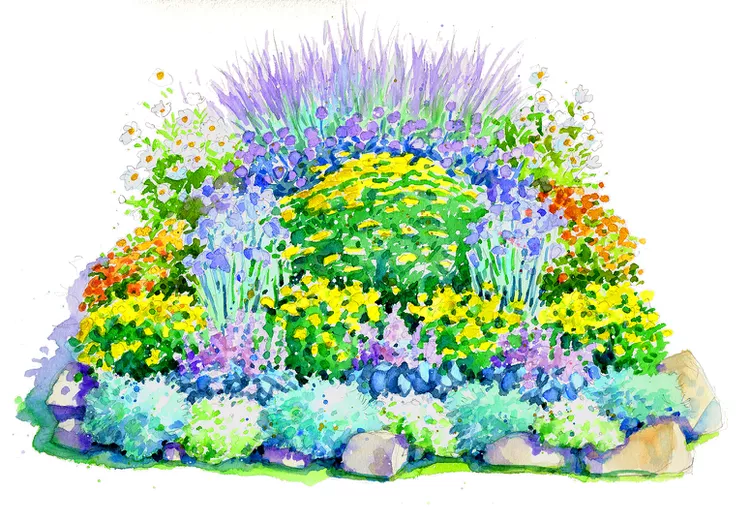This Deer-Resistant Garden Plan Is Filled with Colorful, Long-Lasting Blooms

Deer may look cute, but they can wreak havoc in a garden. One effective strategy to stop them from snacking on your plants is to select varieties that are lower on their menu. This deer-resistant garden plan features several blooming perennials with a scent or texture that the animals don't like. Besides creating a colorful display, these plants don't need much care to look beautiful and are hardy in most areas of the country.
Plants for Creating the Deer-Resistant Garden Plan
This garden plan contrasts the purple blooms of Russian sage, globe thistle, iris, and lamb's ears with warm yellow flowers of spurge and yarrow, accented by the warm orange flowers of potentilla. The low-growing foliage of artemisia and thyme gives the front of the bed a clean finish.
- 4 'Silver Mound' artemisia (Artemisia schmidtiana), Zones 4-8
- 3 Creeping thyme (Thymus praecox 'Albiflorus'), Zones 4-9
- 3 Lamb's ears (Stachys byzantina), Zones 4-9
- 4 Cushion spurge (Euphorbia polychroma), Zones 3-10
- 2 Variegated sweet iris (Iris pallida 'Variegata'), Zones 4-9
- 1 Fernleaf yarrow (Achillea filipendulina' Gold Plate'), Zones 3-9
- 2 Potentilla (Potentilla fruticosa ‘Sunset’), Zones 2-7
- 3 Globe thistle (Echinops bannaticus 'Blue Glow'), Zones 5-9
- 2 Peony (Paeonia 'Crinkled White'), Zones 4-8
- 3 Russian sage (Perovskia atriplicifolia), Zones 4-9
If you can't find the exact cultivars listed above, try to find others that offer similar colors, shapes, and sizes.
Because some plants can become overly aggressive and spread out of control in certain climates, always check which species are considered invasive in your area before planting. For example, lamb's ear has been reported as invasive in a few areas because it reseeds itself prolifically and roots easily from any stems touching the ground. Get a similar look by swapping in a compact variety of catmint (Nepeta spp.) such as 'Cat's Pajamas'.
Get the Free Deer-Resistant Garden Plan
This garden design includes an illustrated version of the planted garden, a detailed layout diagram, a list of plants for the garden as shown, and complete instructions for installing the deer-resistant garden.